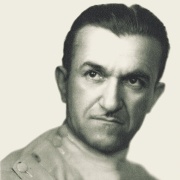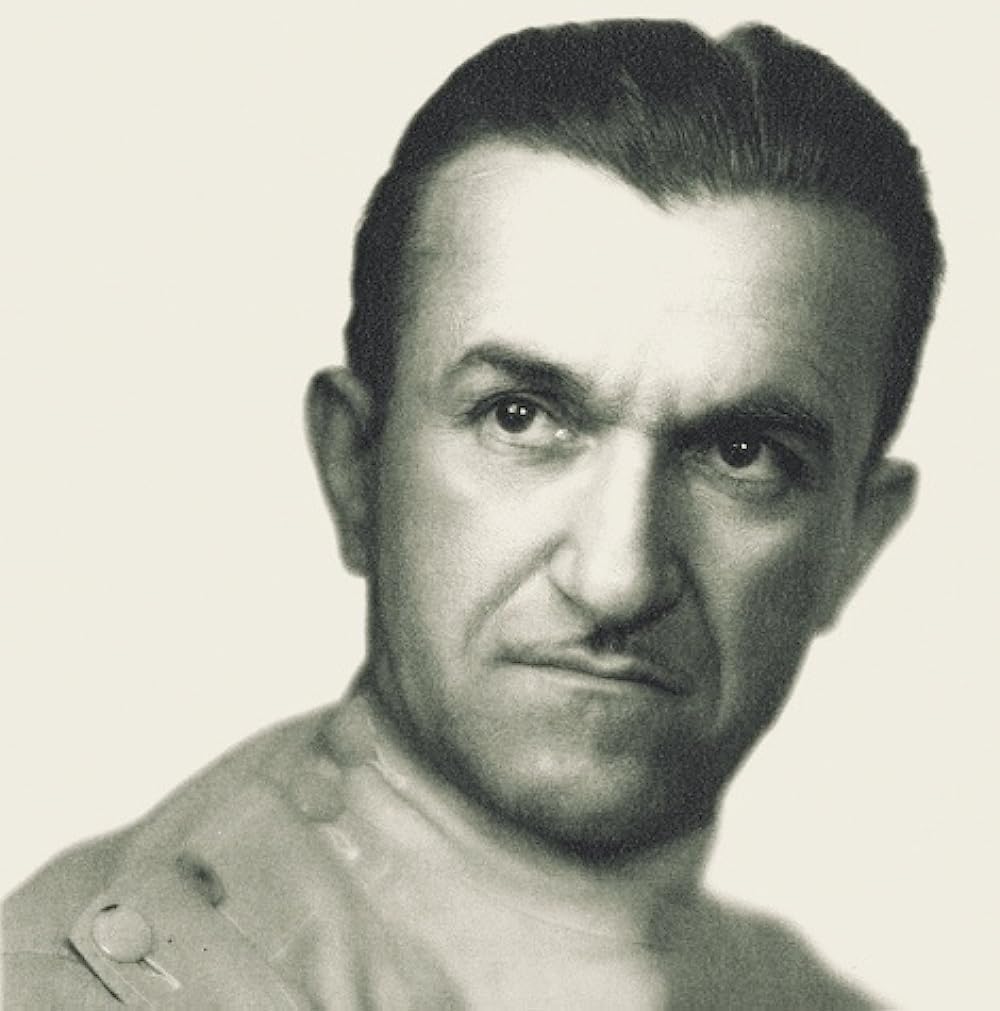

Bio: As we look back on the cinematic pioneers of the 20th century, no individual is more significant in his field than genius makeup artist Jack Pierce, the legendary monster-maker who worked in the 1930s and 1940s at Universal Studios during its classic horror period. Pierce's story is equal parts triumph and tragedy. After emigrating to the US from Greece at the turn of the century, he attempted to play baseball, unsuccessfully trying out for a semi-professional team in California after achieving some notoriety as a shortstop in Chicago. He next worked in the fledgling motion picture industry in the 1910s and 1920s, trying his hand at a variety of jobs from nickelodeon manager to stuntman to assistant cameraman. At this time Universal was a nascent little studio in the San Fernando Valley, referred to as "Universal City" in 1915, after only three years in business. The brainchild of former haberdasher Carl Laemmle, Universal was the home to many silent shorts in the 1910s, several of which featured the talents of an unknown actor named Lon Chaney, who got work by creating his own unique makeups, transforming his entire face and body in the process.Pierce eventually drifted into acting, then makeup, working at Vitagraph and the original Fox Studios in the 1920s. By 1928, after Chaney had left to freelance stardom, Universal made Pierce head of the makeup department, where he worked on the last of the silent films made at the studio. His fortune was cemented when Carl Laemmle made his son, Carl Laemmle Jr., head of production as a 21st-birthday present. Called "Junior" by his peers and colleagues, Laemmle Jr. decided to produce film versions of classic horror novels, encouraged by Chaney's huge successes with The Hunchback of Notre Dame (1923) and The Phantom of the Opera (1925) at Universal in the mid-'20s. Laemmle's personal tastes couldn't have been any more fortuitous for Pierce: from 1930-1947 Pierce created some of cinema history's most distinguishable screen characters.In 1930 Dracula (1931) was first produced, and though Bela Lugosi refused to let Pierce apply his makeup (the actor had come from the stage where he always did his own work), Pierce came up with the styling for the vampire character and his many female victims. Immediately following the success of "Dracula", Junior wanted a follow-up, which led to the production of Frankenstein (1931) in 1931. Though many have argued as to whether director James Whale, actor Boris Karloff or Junior himself contributed to the makeup, the driving force behind the look of the character unquestionably belonged to Jack Pierce. Every morning Karloff sat for four uncomfortable hours, suffering the makeup's high levels of toxicity, as Pierce and his assistants applied the head, facial buildup and layers of padding and costume modifications that would make him into the movies' most memorable monster. For the 43-year-old Karloff and 42-year-old Pierce it was a remarkable achievement--their legend would have been guaranteed even if they had stopped their unique artist-performer collaboration right then and there. Furthering their reputation, though, Pierce and Karloff teamed the following year to create The Mummy (1932). Though the actual creature is only seen for a matter of seconds, it was another unforgettable achievement in cinema horror when "In-Ho-Tep" came alive and paraded across an unearthed Egyptian tomb. Karloff spent most of the picture as "Ardath Bey", another Pierce incarnation, the doomed prince looking for his lost bride.The Laemmles also tried to get new cinematic treatments of "Phantom of the Opera" and "Hunchback" off the ground at this time. Lon Chaney had died in 1930, but many of their efforts stalled. A version of "The Wolf Man" with Karloff was even planned, but this, too, would be derailed due to production problems. If you can't initiate wholly original projects, why not try a sequel? Universal did just that, starting a trend that would result in numerous Dracula, Frankenstein and Mummy spin-offs, which became its trademark.First on the boards was what would be the final horror film in the Laemmle period, The Bride of Frankenstein (1935). Revamping his first version of the monster, Pierce also created the famous makeup and designed the electric hairstyle for Elsa Lanchester's bride. Once again, Pierce created an iconic movie character who only appeared on screen very briefly at the end of the film. Then, in an instance of commerce overwhelming art, the Laemmles sold the studio in 1937, ushering in a series of revolving studio heads at Universal for the next 10 years.In the many comings and goings of Universal executives in the late 1930s and early 1940s, Pierce did manage to retain his level of high-quality character makeups in several cranked-out sequels and B-movies. For Lugosi, with whom Pierce had locked horns several years earlier on "Dracula", Pierce created "Ygor" in 1939's Son of Frankenstein (1939). Conceived as a man who couldn't be hanged, the bearded, gnarled-toothed wretch became Lugosi's most original character in years and put him back on the map. Two years later Pierce pulled out all the stops for The Wolf Man (1941) with Lon Chaney Jr. in the title role. Though the two reportedly did not get along--Chaney did not like wearing the makeup or undergoing the lengthy application and removal period--Pierce excelled again with his werewolf concept, utilizing a design he had created for Karloff a decade earlier. Originally intended as a B-movie, The Wolf Man (1941) was a true horror classic, and Pierce's version of the character has been the model for the numerous werewolves that have since come to the screen.The final, original Pierce makeup arrived in 1943 with Phantom of the Opera (1943). Starring Claude Rains (it would be the only Jack Pierce monster movie shot in color). Though his treatment of Claude Rains' makeup--revealed only at the end of the film--was cut down at the request of the producers (Pierce's original concept was considered too hideous!), it stands as another horror movie landmark.Jack Pierce's reign at Universal ended shortly after WWII when the studio merged with International Pictures and replaced many of its department heads. He had been a makeup supervisor for 19 years and worked at the studio for 30 years, but Pierce ended his career working in low-budget independent films and television projects during the final 20 years of his life. His last project was working as makeup department head for the TV show Mister Ed (1961) from 1961-1964. Unthinkably, he died in virtual obscurity in 1968. However, today's artists still view Pierce's work as a relevant force in the annals of cinema crafts, and Pierce has been honored with a tribute DVD, a lifetime achievement award by the makeup union, and a proposed forthcoming star on Hollywood Boulevard.
Tivia: The mask work by Lon Chaney Jr. in The Mummy's Curse (1944) and preserved by Bob Burns, is the only surviving example of his makeup.A photograph of his hands appears on one stamp of a sheet of ten US 37�� commemorative postage stamps, issued 2/25/2003, celebrating American Filmmaking: Behind the Scenes. The stamp, which honors makeup artists, shows Boris Karloff being transformed into the monster he portrays in Frankenstein (1931).Despite having created most of the famous make-up designs for the monsters in the Universal Studios horror classics, almost all of this work was uncredited.He initially went to California to try out as a shortstop in the Pacific Coast League.Alan Young reminisces about Mister Ed (1961) makeup man Pierce in the book "A Sci-Fi Swarm and Horror Horde" (McFarland & Co., 2010) by Tom Weaver.Albeit uncredited, an actor plays him in A Star Is Born (1937). He approaches Vicki Lester (Janet Gaynor), and takes a disapproving look at her face. A few minutes later, he is deciding on her new eyebrows design and lipstick. The actor is dressed in Pierce's customary white lab coat, equally buttoned to the side, and sports a version of his toothbrush mustache.